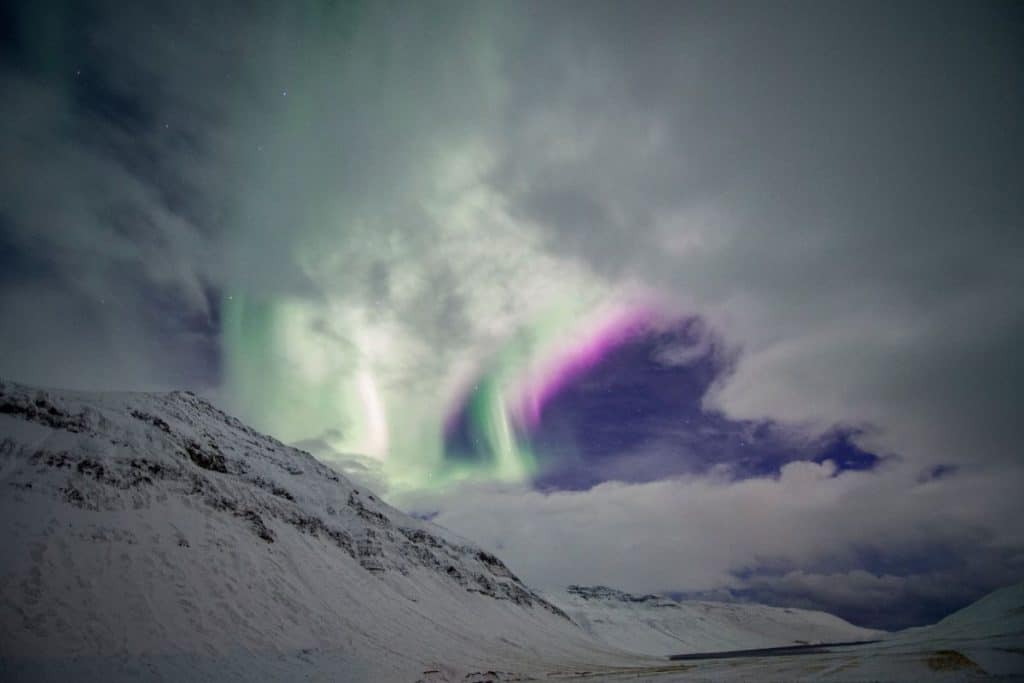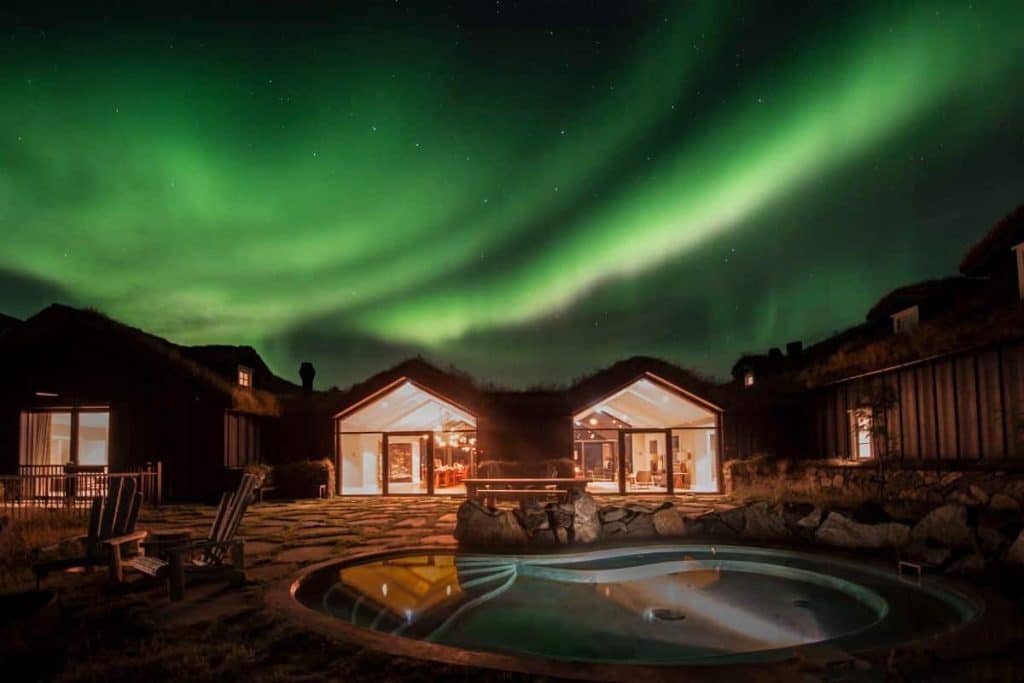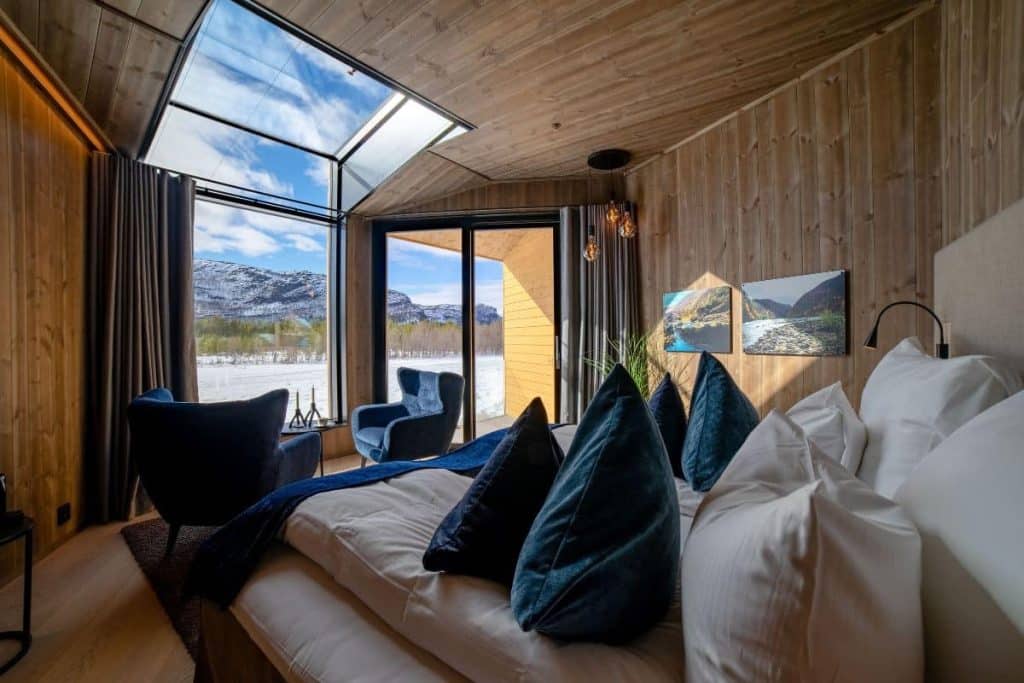On some nights they will appear as a subtle green shimmer. On others, they erupt into a rainbow of neon red, violet and pink hues. Known as aurora borealis, the Northern Lights have attracted visitors to the Arctic Circle for hundreds of years in hope to witness this captivating light show.
This year, however, visitors may not have to rely on serendipity to witness this colourful spectacle. Sunspot observations, an indicator of the likelihood for Northern Lights, have increased dramatically since the end of 2022.
Forecasted to reach its peak by autumn 2024, scientists predict that the next eighteen months will bring the most intense Northern Lights activity seen in the past two decades, and likely in the coming decade, too.
“We might see very bright, long lasting, dancing auroras in the sky. It could also mean there will be more colours involved,” says Markus Mäntykannas, Meteorologist at Foreca and MTV Finland.
While auroras are usually associated with green or purple tones, Mäntykannas shares that recent observations in Finland have reported a growing frequency of red auroras, a hue that is not only less common but often linked to a particularly powerful solar event. The increased activity means that the aurora borealis, will not only be more frequent but also visible from more places on Earth.
“You could see auroras at unusually low latitudes, such as Central Europe, and on rare occasions, even down to the northern parts of the Mediterranean, such as Spain and Italy,” Mäntykannas adds. Recently, auroral activity was spotted as far south as Bulgaria and England — areas not typically known for the Northern Lights.

Of course, higher latitudes do play an instrumental role in catching this celestial event. Mäntykannas highlights that the frequency of sightings significantly increases as one ventures further north, particularly within the 70–75 degrees latitude band, spanning regions such as Lapland, Svalbard, or Iceland. “In northern Finland, Sweden or Norway, auroras are visible on average every two to three nights, when the weather permits.”

What to know, wherever you go
Many new aurora chasers make the common mistake of not travelling north enough. Cities such as Stockholm, Oslo, and Helsinki, situated below the Arctic Circle, may not provide the best vantage points due to their lower latitudes and light pollution.
“Auroras are only visible when the sky is dark enough,” Mäntykannas clarifies. Weather conditions, of course, also affect the chances of sighting the auroras. “Whenever the sky is cloud–covered, you will need to be patient.
Usually, the cloudiest months in northern Europe are November, December, and January. The months of September, October, February, March, and even April tend to have clearer skies,” he explains.
During a full moon, the additional light can interfere with aurora observations. Mäntykannas suggests aligning your aurora chase during other moon phases to optimise viewing opportunities.

When is the best time?
Although the aurora borealis exists throughout the year, the optimal period for viewing the Northern Lights is during the equinoxes in March and September “Strong auroras typically occur close to these equinoxes,” Mäntykannas notes. The likelihood of sightings also varies with the time of night, peaking around midnight. The Northern Lights tend to appear and disappear in cycles, creating a celestial performance that can last throughout the night when the activity is high. “I’ve seen auroras that last for more than 30 minutes in a row, but usually, they are visible for five to 20 minutes at a time,” Mäntykannas shares.
How to increase viewing opportunities
Mäntykannas highly recommends the northern regions of Finland, particularly the areas around Kilpisjärvi or Inari. These remote regions, he asserts, provide minimal light pollution and a level of silence that often enhances the whole experience. “Whenever the auroras show up, you can almost hear them.” he shares. This serene tranquillity makes the chase for the Northern Lights far more majestic.
Offering some practical advice, he suggests to “rent a car, dress warmly, adjust your camera settings in advance, and venture as far away from light pollution as possible.” With solar activity projected to peak in under a year, Mäntykannas advises to make travel plans as soon as possible, suggesting that the optimal period to witness this majestic spectacle will be at its best until 2026.

Where to stay
Arctic bath hotel
Location: Harads, Sweden
The Arctic Bath Hotel is an experience that truly needs to be seen to be believed. Located along the shores of the Lule River in Swedish Lapland, this unique hotel stands out with its dramatic architecture.
The centrepiece of the resort resembles a giant bird’s nest combined with a fantasy setting taken straight from the Game of Thrones. Flanking it on each side are six additional floating cabins, each discreetly accessible via wooden walkways. On land, another half dozen larger cabins blend seamlessly into the surrounding pine forest and shoreline.
Beyond the spectacular views of the Northern Lights, the Arctic Bath Hotel is focused around the Scandinavian tradition of ice bathing. Known as “kallbad”, this Swedish ritual involves plunging into the river’s frigid waters for mental and physical wellness benefits.

If the icy waters in the open–air bath seem too extreme, guests can opt for one of the three saunas, outdoor jacuzzis or choose from an array of relaxing treatments at the spa. The hotel rooms are sustainably constructed using local materials and designed to have very little environmental impact. The floating cabins can accommodate up to two guests whereas the cabins on land are designed to host up to five guests.

The on–site restaurant pays homage to local Swedish cuisine with a modern twist. Head chef David Staf crafts a “Culinary Arctic Dinner Experience” from pure, natural ingredients. Guests can indulge in artistically plated, seasonal meals that align with the hotel’s wellness focus. The overall experience provides a one–of–a–kind immersion into the Swedish culinary culture.

Six Senses Svart
Location: Meløy, Norway
Set to open its doors later this year, Six Senses Svart aims to become the first energy positive hotel. Standing ‘weightlessly’ at the foot of a striking glacier, the hotel is in the process of setting new standards in carbon-neutral and sustainable travel experiences.
Nestled within the Arctic Circle near Norway’s Svartisen glacier, this futuristic 94-room resort is suspended above the fjord on poles to minimize environmental impact. Completely off-grid and self-sustaining, the delicately designed property combines natural materials and green technology to not only power itself but other activities too, such as the net-zero emission boat shuttle.

Drawing inspiration from traditional Norwegian fisherman’s cabins, known as “rorbue”, Six Senses Svart’s circular design aims to create a sense of openness that blends land and fjord. The result provides panoramic views and increased space between rooms for privacy. The roof of the hotel has been designed to collect energy, adding to the concept of being self-sustaining.
With wellness at its core, Six Senses Svart offers its signature spa treatments plus a new touchless technology that adapts guest rooms to your state of mind. Enjoy IV drips, indulgent scrubs and witness eco-initiatives at the on-site “Earth Lab”. Savour fresh local cuisine at the zero-waste restaurant before gazing at the Northern Lights in an energy-positive haven.

Arctic Treehouse Hotel
Location: Rovaniemi, Finland
Resembling high–end treehouses, the Arctic Treehouse hotel consists of individual rectangular chalets located within a forested hillside within the Arctic Circle. Each chalet is north–facing with floor–to–ceiling windows, ideal for viewing the Northern Lights and surrounding wilderness.
Guests can choose from the Arctic TreeHouse Suites, Arctic GlassHouses, and the spacious ArcticScene Executive Suites. The latter is especially suitable for larger families and includes a separate wellness area. These suites also feature an outdoor and indoor fireplace, sauna, bath tub and patio, allowing guests to enjoy the arctic winters in comfort.
In the main snowflake shaped building, guests will find the hotel’s onsite restaurant Rakas, a wellness centre and guest lounge. Besides taking in the natural surroundings, guests can enjoy activities such as snowmobiling, snowshoeing or perhaps, for those brave enough, an arctic floating experience in the ice–cold Sierijärvi lake.

Deplar Farm
Location: Troll Peninsula, Iceland
Iceland boasts a plethora of remarkable hotels for observing the Northern Lights, yet Deplar Farm holds a unique charm. Nestled in the valleys of northern Iceland, this former sheep farm has been transformed into a 13-suite luxury hotel for aurora chasers.
With nearly zero light pollution, guests can witness the Northern Lights in their full splendour from the hotel suites, on guided tours, or while unwinding in the geothermally heated outdoor pool.
Situated in Iceland’s snowiest region, Deplar Farm is a winter wonderland for outdoor adventure seekers. Activities such heli–skiing, snowmobiling and dog sledding are available for those wanting an adrenaline rush. Whale watching excursions can also be arranged year–round.
Onsite facilities include a spa, floatation therapy rooms, a media lounge and an observatory equipped with telescopes. After an active day of exploring, Deplar Farm’s talented chefs create a tailored three–course menu showcasing the region’s finest ingredients. Pescatarians can indulge in locally caught seafood, while meat lovers can savour succulent lamb and beef, all whilst taking in the vast surrounding mountain views.

Sorrisniva Arctic Wilderness Lodge
Location: Alta, Norway
Known for its frequent aurora displays, Alta has often been referred to as the “City of Northern Lights.” It is also here that the world’s first aurora observatory was established. Located just a stone’s throw away, Sorrisniva Arctic Wilderness Lodge emerges as the ideal base to explore this region.
While Sorrisniva is most famous for its seasonal igloo hotel, the Arctic Wilderness Lodge is a better option for those who prefer more high–end accommodation. Perched along the picturesque Alta River, the 24–room hotel features floor–to–ceiling windows that offer daytime river views and night–time Northern Lights displays. Each room and suite comes with a balcony for enhanced viewing pleasure.

The lodge hosts two on–site restaurants, Maku and Lavvu, which both focus on local ingredients. On the menu, guests can expect reindeer, moose and fresh fish caught from the river. Both dining venues, along with a lounge and bar, offer riverside views. Guests also have the option to partake in various nature–centric activities such as snowmobile excursions, King Crab fishing, ice sculpting, reindeer sleigh rides, and of course, expert–guided tours of the northern lights.









